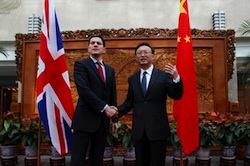China Increasingly Concerned about Iran's Nuclear Program
March 16, 2010
Featured Image
We are happy to serve you a daily summary of the day's top nuclear policy stories each morning, with excerpts from the stories in bullet form.
Stories we're following today:
China 'More Concerned' About Iran's Nuclear Policy - Bloomberg [link]
- China is growing more concerned about Iran’s nuclear intentions, Foreign Minister Yang Jiechi said at a joint press conference with his U.K. counterpart.
- The comments from Iran’s biggest trading partner may mark a narrowing of the gap between China and the U.S., U.K., Germany and France in how to tackle Tehran’s atomic program. Iran maintains that it is only interested in civilian uses, while the U.S. maintains the regimes wants to develop weapons.
- The United States and its European allies are pushing for United Nations sanctions against Iran to force the country back to negotiations over its nuclear enrichment plans. China holds veto powers as one of the five permanent members of the United Nations Security Council.
- “Regarding the Iranian nuclear issue, I wish to point out that this issue is subject of widespread attention of the international community,” Yang said. “China has become more concerned about the current situation.”
The Climatic Consequences of Nuclear War - Steven Starr in the Bulletin of the Atomic Scientists [link]
- Although the ongoing Nuclear Posture Review is supposed to include all aspects of the strategy and doctrine that govern the use of U.S. nuclear weapons, it once again will not consider one crucial question: What would be the long-term consequences to Earth's environment if the U.S. nuclear arsenal were detonated during a conflict?
- This isn't a question to be avoided. Recent scientific studies have found that a war fought with the deployed U.S. and Russian nuclear arsenals would leave Earth virtually uninhabitable.
- Similarly, in the January Scientific American, Alan Robock and Brian Toon, the foremost experts on the climatic impact of nuclear war, warn that the environmental consequences of a "regional" nuclear war would cause a global famine that could kill one billion people. Their article, "Local Nuclear War: Global Suffering," predicts that the detonation of 100 15-kiloton nuclear weapons in Indian and Pakistani megacities would create urban firestorms that would loft 5 million tons of thick, black smoke above cloud level. (This smoke would engulf the entire planet within 10 days.)
- Regardless of how "safe from use" U.S. and Russian nuclear weapons are considered to be, they still could wipe out humanity. Thus, the recognition by Washington that its nuclear arsenal, if used in conflict, will make the whole world--including all of its territory--uninhabitable, is long overdue.
Reports Shine Light on Nuclear Weapons Vigilance - Walter Pincus in the Washington Post [link]
- While public attention is focused on a new arms-control treaty between Russia and the United States, the slow, dull work of keeping nuclear warheads and weapons-grade uranium and plutonium protected from terrorists goes on almost unnoticed.
- But two new reports have shed light on the subject. A fascinating study on China's system of securing its nuclear weapons was published last week. Two days earlier, an update on the multiyear U.S. effort to secure Russian nuclear sites, and those of other countries, was presented to the House Appropriations subcommittee on energy and water, which has jurisdiction over funding for the U.S. nuclear weapons complex.
Funding the Fight Against Nuclear Terrorism - Kenneth Luongo in Stimson Center's Budget Insight [link]
- Just about a year ago, President Obama made a very bold pledge to “secure all vulnerable nuclear materials around the world within four years” in order to prevent a nuclear terrorist attack.
- This year, in the State of the Union address, the President restated his four year objective and received a bipartisan standing ovation – rare for that event. He then submitted a budget for 2011 that was $320 million over the FY10 budget for this agenda and forecast growth in the coming years for key programs run by the National Nuclear Security Administration (NNSA). But is this more robust budget adequate to meet the President’s objective?
- At the end of the day the President’s four year goal is unlikely to be met in the timeframe he has endorsed for budgetary, bureaucratic, and diplomatic reasons. But, incrementally funding the fight against nuclear terrorism is a prescription for making it more likely rather than reducing its likelihood. If it occurs, the cost of the response will dwarf the cost of its inadequately funded prevention.
Air Force Thinkers: A Lot of Nukes Overrated - Nukes of Hazard [link]
- What’s gotten into the Air Force lately? First there was this December 2009 report from the Air Force Association’s Mitchell Institute for Airpower Studies calling for a bomberless dyad.
- Now, in an article in the latest issues of Strategic Studies Quarterly co-authored with two professors from Maxwell Air Force Base in Alabama, Col B. Chance Saltzman, chief, Strategic Plans and Policy Division, Headquarters Air Force, calls for significant reductions in the size of the U.S. nuclear stockpile.
- Saltzman et al, argue that such a force could be maintained on a triad of 100 single-warhead Minuteman III ICBMs, 192 de-MIRVed Trident D-5 SLBMs on 12 Ohio class submarines, and ALCMs to be deployed on 19 B-2s. Apart from calling for a triad of counterforce and countervalue weapons, the article mostly ignores the other specific details of deterrence that have consumed so much energy in the context of the ongoing Nuclear Posture Review.



